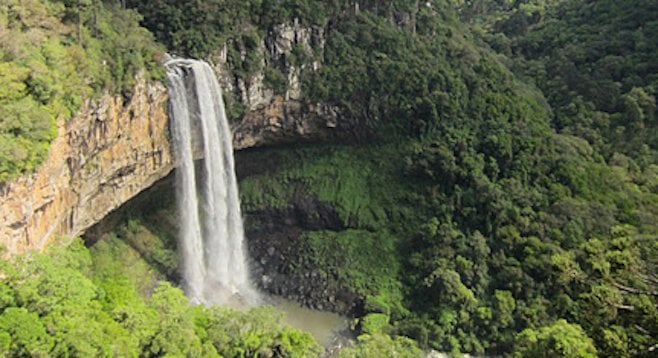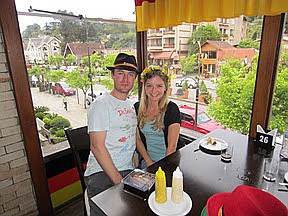 Facebook
Facebook
 X
X
 Instagram
Instagram
 TikTok
TikTok
 Youtube
Youtube

Below the heat and subtropical savannas that spread out across millions of acres of the sub-Amazonian Brazilian interior is the Serra Gaúcha.
"Serra" is a Latin American subtropical forest.
The Gaúcho is the Latin American mythic cowboy. Like the cowboy of the American West before it was divided into states, he intimates Brazil's rich southern Latin American mythodrama. The gaúcho is an archetype that remains beyond years of war, borderlines and bloodshed.
"Gaúcho" also remains the demonym for the residents of Brazil's southernmost state, Rio Grande do Sul ("large southern river").
Seventy-five miles from the state's coastal capital (Porto Alegre) is one of about three places in Brazil where a North American can feel comfortably cold: Gramado. Excluding its affinity for tacky life-sized statuettes of monks and animals and Italian waiters, the town can convince the traveler that they’ve awoken in some strange corner of Europe: the hydrangea-lined streets, the romance of the sylvan deep south, Gramado is a South American anomaly, wrought from several periods of mass emigration of Germans, Italians and Portuguese.
The town, as alluded to before, is the tourist-oriented (though by no means Gringo-oriented), polycultural capital of the state. Residents are descendants of Germans (30%), Italians (30%) and Portuguese (30%), and the remaining 10% is made up of indigenous peoples as well as Lebanese and Eastern Europeans.
While there is no dominant narrative for the Gramadenses, there is an underpinning gaúcho spirit that is usually associated with the early Argentine, Paraguayan and Uruguayan vagabonds and nomads who herded cattle during the original European settling of southeastern Latin America. But the gaúcho spirit – a vagrant spirit, a nomadic, immigrant heart, and a deep reverence for the bounty of the pampas (open fields) – is a thread that spans borders while remaining entirely South American.
We don't see gaúchos on the street, but we see wizened older guys, sheepskin on most chairs, leather shops, wool shops, bovine rugs and leather textiles. And we had ample opportunities to taste the beef cooked slowly, and served from spits, in the entirely Brazilian churrascos (barbeques).

The architecture of Gramado is largely inspired by Northern European timber-framed structures with small garden sills, storybook woodworking along tall, triangular roofs with detailed ornamental fringes.
There is the enchantment of the polycultural history beneath the tall, Seussian pines, the rows of hydrangea, and the non-native Christmas firs (planted decoratively by German immigrants).
The most beautifully planned park I've seen in Brazil, Lago Negro, was (according to our guide), designed with dozens of fir pines lining the one-kilometer circumference of the lake.
Above the lake are the endemic "Large River" pines (pinheiro-do-paranás), with their extensive trunks and branches that extend perpendicularly high above the base of the trunk. In the neighboring village, Canela, there's a beautiful park with native flora and the stirring Caracol Falls (above).
There is also a child-oriented "eternal Christmas" culture patterned after Orlando, Lego and the 20th-century American ethos of escapism, as suggested by the following:
1) A year-round Santa's workshop (Adeia do Papai Noel), complete with a working monorail, humans dressed as elves, and rotating staff of Santas.
2) A number of chocolate factories. The entrance to the Lugano factory is the stomach of a giant plastic-and-stucco bear. From a door in the giant bear’s belly, we are quickly ushered into a long corridor where we see people (mostly women), working hastily on bon-bons, bars and chocolate figurines.
3) On the same property, a horrifying wax museum adjacent to a Harley Davidson "World Showroom." Each entrance is R$15.
4) Like Legoland (without the Legos), "Mini Mundo" is a park replete with micro-architecture patterned after Swiss, Bavarian and Norman neighborhoods.
5) Nearly every restaurant or confectioner has a large, molded plastic human or animal beckoning the passerby to the sheepskin-lined chairs (I've included a small, humiliating editorial based solely on pictures with said figurines).
* * *
In reflection I think, this is what we call charm? This is an amalgamation of the enchantment of polyculture, a rich history, (tacky?) escapism and the common Latin American tourist tropes.
Having grown up near Anaheim and the best of escapist kitsch (read: Disneyland), it’s easy for me to mock Latin American attempts to create a culture of dreams and imagination. Then again, I've always preferred story, history, and the endless muse of the natural world to the artificial dreams of Disney. Yes, near Gramado – and greater Rio Grande do Sul – is the home of the mighty Iguaçu (the Brazilian side; thus the spelling).
But it’s also a place of quiet, temperate beauty – a place where a diversity of culture can thrive, and, with the spirit of the Gaúcho, is beginning to create a new story about what it means to be Panamerican.


Below the heat and subtropical savannas that spread out across millions of acres of the sub-Amazonian Brazilian interior is the Serra Gaúcha.
"Serra" is a Latin American subtropical forest.
The Gaúcho is the Latin American mythic cowboy. Like the cowboy of the American West before it was divided into states, he intimates Brazil's rich southern Latin American mythodrama. The gaúcho is an archetype that remains beyond years of war, borderlines and bloodshed.
"Gaúcho" also remains the demonym for the residents of Brazil's southernmost state, Rio Grande do Sul ("large southern river").
Seventy-five miles from the state's coastal capital (Porto Alegre) is one of about three places in Brazil where a North American can feel comfortably cold: Gramado. Excluding its affinity for tacky life-sized statuettes of monks and animals and Italian waiters, the town can convince the traveler that they’ve awoken in some strange corner of Europe: the hydrangea-lined streets, the romance of the sylvan deep south, Gramado is a South American anomaly, wrought from several periods of mass emigration of Germans, Italians and Portuguese.
The town, as alluded to before, is the tourist-oriented (though by no means Gringo-oriented), polycultural capital of the state. Residents are descendants of Germans (30%), Italians (30%) and Portuguese (30%), and the remaining 10% is made up of indigenous peoples as well as Lebanese and Eastern Europeans.
While there is no dominant narrative for the Gramadenses, there is an underpinning gaúcho spirit that is usually associated with the early Argentine, Paraguayan and Uruguayan vagabonds and nomads who herded cattle during the original European settling of southeastern Latin America. But the gaúcho spirit – a vagrant spirit, a nomadic, immigrant heart, and a deep reverence for the bounty of the pampas (open fields) – is a thread that spans borders while remaining entirely South American.
We don't see gaúchos on the street, but we see wizened older guys, sheepskin on most chairs, leather shops, wool shops, bovine rugs and leather textiles. And we had ample opportunities to taste the beef cooked slowly, and served from spits, in the entirely Brazilian churrascos (barbeques).

The architecture of Gramado is largely inspired by Northern European timber-framed structures with small garden sills, storybook woodworking along tall, triangular roofs with detailed ornamental fringes.
There is the enchantment of the polycultural history beneath the tall, Seussian pines, the rows of hydrangea, and the non-native Christmas firs (planted decoratively by German immigrants).
The most beautifully planned park I've seen in Brazil, Lago Negro, was (according to our guide), designed with dozens of fir pines lining the one-kilometer circumference of the lake.
Above the lake are the endemic "Large River" pines (pinheiro-do-paranás), with their extensive trunks and branches that extend perpendicularly high above the base of the trunk. In the neighboring village, Canela, there's a beautiful park with native flora and the stirring Caracol Falls (above).
There is also a child-oriented "eternal Christmas" culture patterned after Orlando, Lego and the 20th-century American ethos of escapism, as suggested by the following:
1) A year-round Santa's workshop (Adeia do Papai Noel), complete with a working monorail, humans dressed as elves, and rotating staff of Santas.
2) A number of chocolate factories. The entrance to the Lugano factory is the stomach of a giant plastic-and-stucco bear. From a door in the giant bear’s belly, we are quickly ushered into a long corridor where we see people (mostly women), working hastily on bon-bons, bars and chocolate figurines.
3) On the same property, a horrifying wax museum adjacent to a Harley Davidson "World Showroom." Each entrance is R$15.
4) Like Legoland (without the Legos), "Mini Mundo" is a park replete with micro-architecture patterned after Swiss, Bavarian and Norman neighborhoods.
5) Nearly every restaurant or confectioner has a large, molded plastic human or animal beckoning the passerby to the sheepskin-lined chairs (I've included a small, humiliating editorial based solely on pictures with said figurines).
* * *
In reflection I think, this is what we call charm? This is an amalgamation of the enchantment of polyculture, a rich history, (tacky?) escapism and the common Latin American tourist tropes.
Having grown up near Anaheim and the best of escapist kitsch (read: Disneyland), it’s easy for me to mock Latin American attempts to create a culture of dreams and imagination. Then again, I've always preferred story, history, and the endless muse of the natural world to the artificial dreams of Disney. Yes, near Gramado – and greater Rio Grande do Sul – is the home of the mighty Iguaçu (the Brazilian side; thus the spelling).
But it’s also a place of quiet, temperate beauty – a place where a diversity of culture can thrive, and, with the spirit of the Gaúcho, is beginning to create a new story about what it means to be Panamerican.
Comments